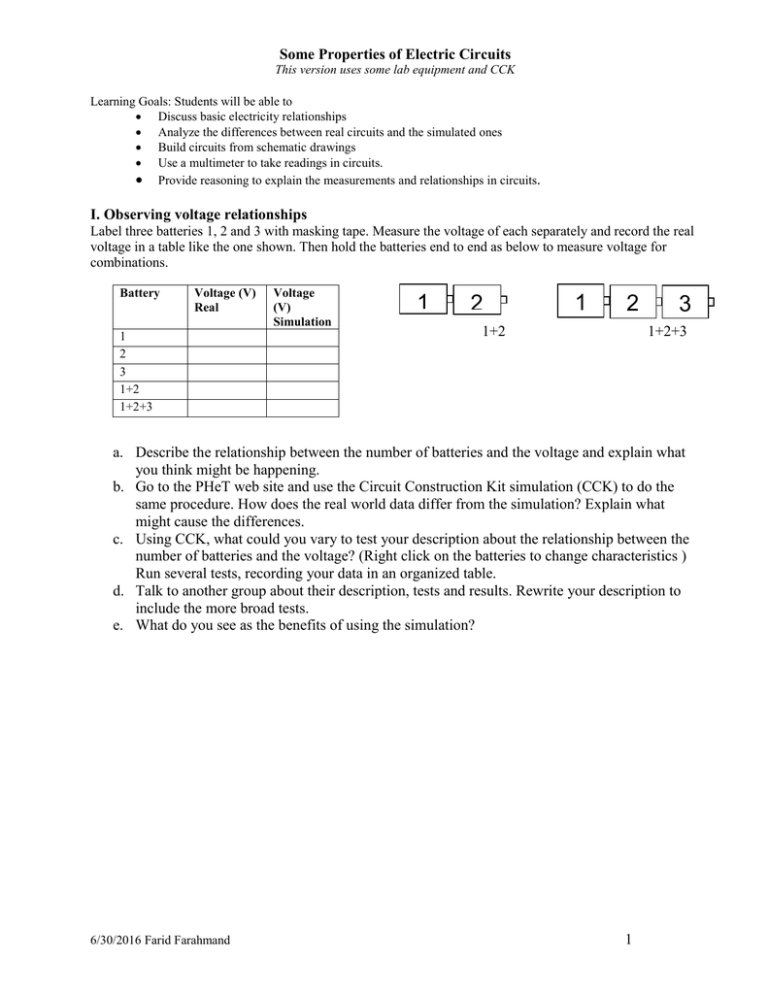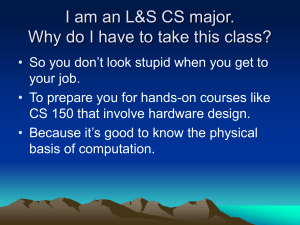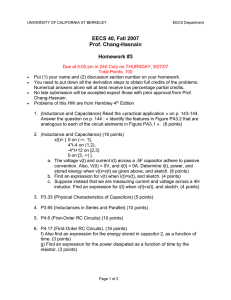First assignment
advertisement

Some Properties of Electric Circuits This version uses some lab equipment and CCK Learning Goals: Students will be able to Discuss basic electricity relationships Analyze the differences between real circuits and the simulated ones Build circuits from schematic drawings Use a multimeter to take readings in circuits. Provide reasoning to explain the measurements and relationships in circuits. I. Observing voltage relationships Label three batteries 1, 2 and 3 with masking tape. Measure the voltage of each separately and record the real voltage in a table like the one shown. Then hold the batteries end to end as below to measure voltage for combinations. Battery Voltage (V) Real 1 2 3 1+2 1+2+3 Voltage (V) Simulation 1 2 1 2 1+2 3 1+2+3 a. Describe the relationship between the number of batteries and the voltage and explain what you think might be happening. b. Go to the PHeT web site and use the Circuit Construction Kit simulation (CCK) to do the same procedure. How does the real world data differ from the simulation? Explain what might cause the differences. c. Using CCK, what could you vary to test your description about the relationship between the number of batteries and the voltage? (Right click on the batteries to change characteristics ) Run several tests, recording your data in an organized table. d. Talk to another group about their description, tests and results. Rewrite your description to include the more broad tests. e. What do you see as the benefits of using the simulation? 6/30/2016 Farid Farahmand 1 Some Properties of Electric Circuits This version uses some lab equipment and CCK III. Using voltage in series circuits Use CCK to build the circuits below with a battery at about 12 volts and light bulbs. Turn on the voltmeter and ammeter to measure voltage of the battery and current into it. Record bulb brightness with descriptive language. Figure 1 Figure 2 Figure 3 # of bulbs Battery voltage (v) Current into battery (A) Brightness of bulbs 1 2 3 a. Summarize the relationships you observed and explain what you think is happening. b. Test to see if changing the battery voltage causes you to modify any of your conclusions. Explain what you measured and any conclusions you draw from your tests. c. What happens when you take a wire out of a circuit? Explain what you think is happening d. Practice using the voltmeter and realistic ammeter in several circuits. Describe how using a voltmeter is different from using an ammeter. IV. Using voltage in parallel circuits Redo Part III but use figures 4-6 for the circuits. Make a new table and answer the questions. Figure 4 Figure 5 6/30/2016 Farid Farahmand Figure 6 2 Some Properties of Electric Circuits This version uses some lab equipment and CCK V. Observing voltage and current relationships with resistors Get a real resistor that is less than 100. Connect the following circuits without the meters. Then use one multimeter to get your readings by changing the mode and moving it. Record your data in a table like the one below. V V V A A Number of batteries 1 Voltage (V) A Current (A) 2 3 a. Explain what might be happening to cause the change in current. b. How are current and battery voltage related? What would be the shape of the graph? c. Describe how you could use the simulation to verify the relationship. Test your ideas and make modifications to your original answers if necessary. Be sure to explain your reasoning. 6/30/2016 Farid Farahmand 3 Some Properties of Electric Circuits This version uses some lab equipment and CCK Answer to the following questions: VOLTAGE a. What can you do to increase the voltage in the circuit? RESISTANCE: e. List ways that you could increase the resistance in the circuit (think about the circuits PhET sim) b. What happens to the current? f. What happens to the current when you change resistance? c. What would that do to a light bulb? g. What would that do to a light bulb when you change resistance of the circuit? d. Are voltage and current directly proportional or inversely? h. Are the resistance and current directly proportional or inversely? 6/30/2016 Farid Farahmand 4







